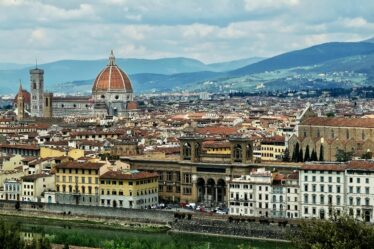

The meaning of the statue of Judith and Holofernes by Donatello (1453-1457) in Piazza Signoria reminded me of a memory of when I attended the Art School. Donatello’s masterpiece statue was probably commissioned by Cosimo the Elder or his son Piero the Gouty, perhaps intended for a fountain and placed in the garden of Palazzo Medici. The sculptor’s mature work invites the viewer to walk around the statue in order to appreciate all the details, a new concept compared to the classic way of seeing the statue from the front. After the expulsion of the Medici family in 1494, the Florentine government decided to place this work in front of Palazzo Vecchio, but why all this? It was the image of a power that in a certain way tended to limit the true republican independence of Florence, therefore Giuditta represents the Florentine Republic which cuts off the head of Holofernes who embodies tyranny, a true model or “manifesto” which speaks of the political reality of the city.
A few meters away we find the statue par excellence of the Italian Renaissance, the grandiose work by Michelangelo, the David (1501-1504), symbol of the love of freedom. Hero of the Jewish people, the young man fights against the immense figure of Goliath, killing him with a slingshot, thus transforming himself into the ideal of the small state jealous of its freedom and independence, ready to challenge everyone to defend its city. The David placed almost as a guard over the main door of Palazzo Vecchio is next to another sculptural group, that of Hercules and Cacus (1530-1534) by Baccio Bandinelli. The desire to match Michelangelo unfortunately boils down to two statues with excessive muscle mass without any movement, but political motivation enters here too, that is, the muscular figure of Hercules almost like a bodybuilder today, is none other than Alessandro de’ Medici who personifies the destructive force towards the Florentine Republic represented by Caco.
The cunning and acuteness of the Medici family was not that of destroying the works of art perhaps commissioned by their adversaries, but rather that of adding other works in turn not only to ingratiate themselves with the people but thus creating a public image with a very specific political meaning . Another political meaning can be found in another masterpiece, this time under the Loggia dei Lanzi, it is Benvenuto Cellini’s Perseus (1545-1554). The splendid bronze statue ordered by Cosimo I is nothing more than another clear example of a political character, in this case the Perseus is the statement of Duke Cosimo I who gives a break to republican ideas and experiences. We can therefore define the statues of Piazza Signoria as a sort of political manifesto of the time, embodied in the characters chosen by the great Florentine masters.
Who knows if the next time someone walks in Piazza Signoria they will look at these Renaissance masterpieces in the usual way. if you like this post and you want know more about the city of Florence come with us. we are running our Florence Free Tour from Santa Maria Novella sqiare. Our meeting point is in front of Grand Hotel Minerva, our gude are very happy to show the beuty of our City. Please book in advanve your spot for the tour.


